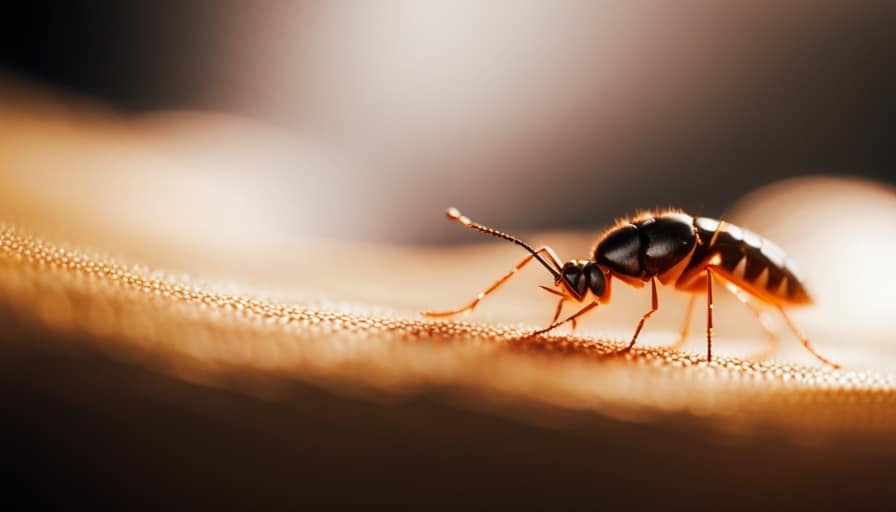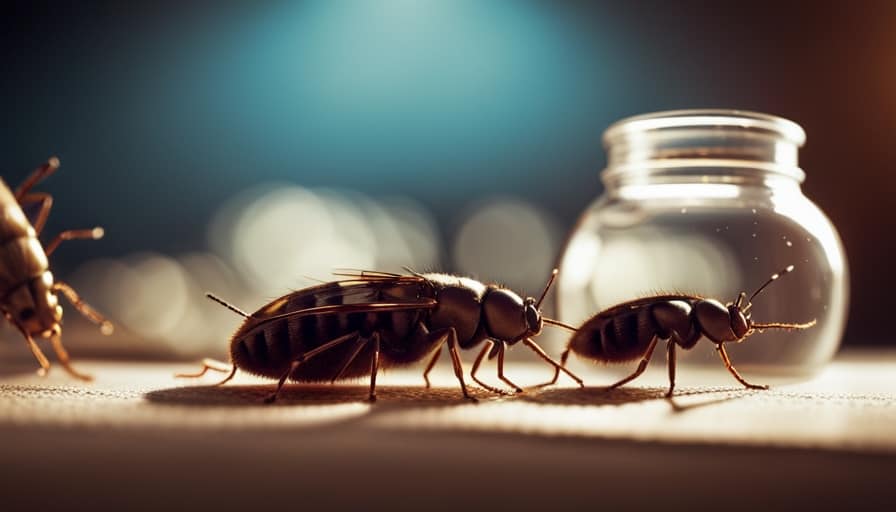Having dealt with the issue of tiny ants invading my living space, I can relate to the frustration and urgency in finding a solution. These bothersome pests seem to emerge out of thin air, creating annoyance and posing potential harm.
But fear not, for I have gathered valuable information and remedies to help you eliminate these tiny intruders. In this article, we will explore the type of ants you’re dealing with, their behaviors, and effective methods to get rid of them.
So, let’s embark on this journey to reclaim our homes from these minuscule invaders.
Key Takeaways
- Identify common hiding places for ants, such as kitchen cabinets, pantry shelves, and bathroom sinks.
- Take note of ant trails leading to food or water sources and look for tiny ant nests and discarded ant wings.
- Differentiate between different types of ants based on size, coloration, and unique features.
- Implement prevention methods like sealing food containers, cleaning up spills promptly, removing standing water, sealing cracks and gaps, and trimming vegetation near the house.
Identifying the Type of Tiny Ants in Your House
I can start by examining the characteristics and behavior of the tiny ants in my house to identify their type. Identifying the type of ants in your house is crucial in implementing the right strategies for their removal.

To begin, it’s important to look for common places where ants hide, such as kitchen cabinets, pantry shelves, and bathroom sinks. These areas provide ants with easy access to food and water sources.
Additionally, signs of an ant infestation include trails of ants leading to food or water sources, tiny ant nests, and discarded ant wings. By closely observing these characteristics and behaviors, it becomes possible to determine the specific type of ants present in your house.
This knowledge will be instrumental in effectively eliminating the infestation and preventing future occurrences.
Understanding the Behavior and Habits of Tiny Ants
To effectively address an ant infestation in your house, it is essential to understand the behavior and habits of tiny ants. By gaining insight into their patterns, you can implement effective ant prevention strategies and identify signs of a tiny ant infestation early on.

Here is a table that provides a summary of the behavior and habits of tiny ants:
| Behavior | Description |
|---|---|
| Trail formation | Tiny ants leave behind a chemical trail to communicate and navigate. This trail can be seen as a line of ants marching towards a food source. |
| Nesting habits | Tiny ants typically build their nests in hidden, dark places such as wall voids, under flooring, or inside electrical outlets. |
| Food preferences | Tiny ants are attracted to sugary substances, crumbs, and food spills. They can also feed on dead insects and organic matter. |
Understanding these behaviors will help you in implementing effective ant prevention strategies and identifying signs of a tiny ant infestation. Now let’s explore natural remedies to eliminate tiny ants.
Natural Remedies to Eliminate Tiny Ants
With a combination of vinegar and cinnamon, you can effectively eliminate tiny ants from your house. Vinegar is a natural ant repellent that disrupts their scent trails and makes it difficult for them to navigate. To use vinegar as a repellent, mix equal parts vinegar and water in a spray bottle and spray it in areas where ants are commonly seen.
Additionally, essential oils such as peppermint, lemon, and tea tree oil can also be used as natural ant control methods. These oils contain compounds that ants find repulsive, causing them to avoid treated areas. Simply dilute a few drops of essential oil with water and spray it around entry points and ant trails.

Chemical Solutions for Getting Rid of Tiny Ants
The most effective way to eliminate tiny ants in your house is by using chemical solutions. Here are some chemical options that can help you get rid of these pests:
-
Ant baits: These are small containers filled with a sweet, sugary substance that attracts ants. The ants consume the bait and bring it back to their colony, effectively eliminating the entire colony.
-
Ant sprays: These sprays contain insecticides that quickly kill ants on contact. They can be used to target specific areas where ants are seen.
-
Ant dust: This is a powder that can be sprinkled around ant trails or entry points. The dust sticks to the ants’ bodies, and when they groom themselves, they ingest the powder, leading to their demise.

-
Ant granules: These granules are spread around the perimeter of your house, creating a barrier that prevents ants from entering. They’re often waterproof and long-lasting.
-
Professional pest control: If the infestation persists, it may be necessary to consult with a professional pest control company. They’ve access to stronger, more effective chemical solutions and can provide targeted treatments to eliminate the ants.
Preventing Future Infestations of Tiny Ants
One effective way to avoid future infestations of tiny ants in my house is by keeping all food stored in airtight containers. This prevents the ants from being attracted to the food and eliminates their access to it.
Additionally, I can take steps to prevent the ants from re-entering my house by sealing all cracks and crevices that they may use as entry points. By inspecting the exterior of my house regularly and sealing any openings, I can create a barrier that deters the ants from entering.

Another method to prevent future infestations is by creating ant deterrents. This can be done by using natural repellents such as vinegar, lemon juice, or peppermint oil, which ants dislike. Placing these deterrents near areas where ants are commonly found can help keep them away.
Frequently Asked Questions
How Do I Get Rid of Tiny Ants in My Outdoor Garden?
To get rid of tiny ants in my outdoor garden, I use natural ant repellents. These include cinnamon, citrus peels, and vinegar. Sprinkling these substances around the garden helps deter ants and keeps my plants safe.
Can Tiny Ants Cause Any Health Issues or Spread Diseases?
Tiny ants can potentially cause health issues and spread diseases. They may contaminate food and surfaces, affecting indoor air quality. To prevent them from entering your house, seal cracks and keep food tightly sealed.
How Long Does It Usually Take to Eliminate a Tiny Ant Infestation?
On average, it takes a few weeks to eliminate a tiny ant infestation using effective methods. It’s important to identify the source, use bait traps, and maintain cleanliness to ensure long-term success.

Are There Any Specific Foods or Items That Attract Tiny Ants?
Specific foods and items can indeed attract tiny ants. They are particularly fond of sugary substances like fruit, soda, and syrup. Additionally, crumbs and food residue left out can be enticing to these pesky creatures.
What Should I Do if I Have Tried Multiple Methods but Still Can’t Get Rid of the Tiny Ants in My House?
If I’ve tried multiple methods but still can’t get rid of tiny ants in my house, I should consider seeking professional help. They have the expertise to identify the source and provide effective solutions. Additionally, I can explore natural remedies as a safer alternative.
Conclusion
After identifying the type of tiny ants in your house and understanding their behavior and habits, there are natural remedies and chemical solutions available to eliminate them.
By using these methods and taking preventive measures, you can successfully get rid of the tiny ant infestation in your home.

Remember to stay vigilant and address any future signs of infestation promptly to maintain a pest-free environment.
I’m Theodore, and I love tiny houses. In fact, I’m the author of Tiny House 43, a book about tiny houses that are also tree houses. I think they’re magical places where imaginations can run wild and adventures are just waiting to happen.
While tree houses are often associated with childhood, they can be the perfect adult retreat. They offer a cozy space to relax and unwind, surrounded by nature. And since they’re typically built on stilts or raised platforms, they offer stunning views that traditional homes simply can’t match.
If you’re looking for a unique and romantic getaway, a tree house tiny house might just be the perfect option.
















